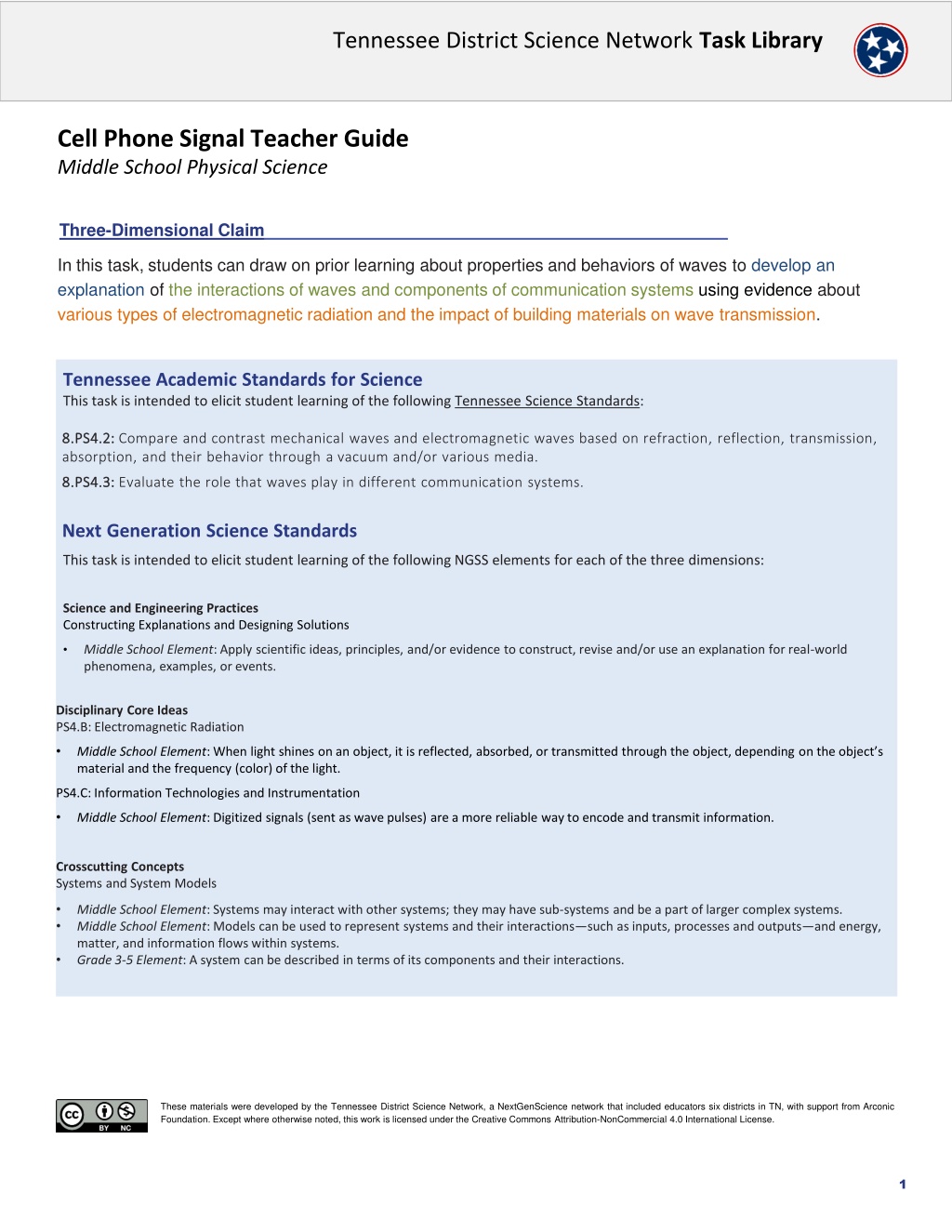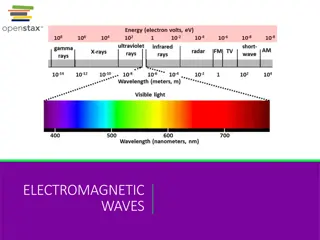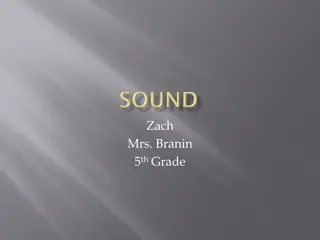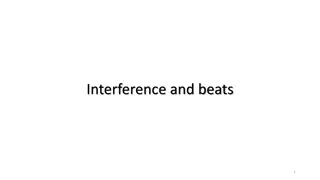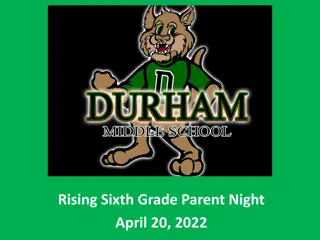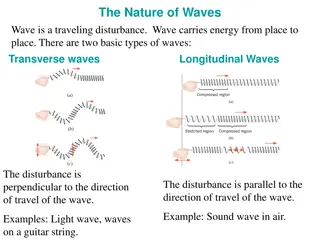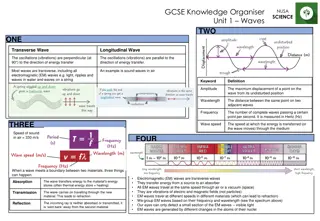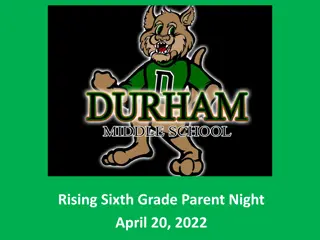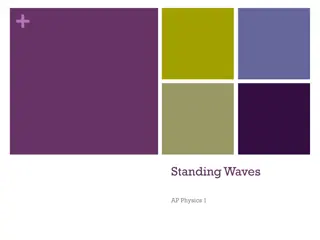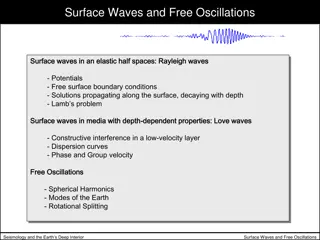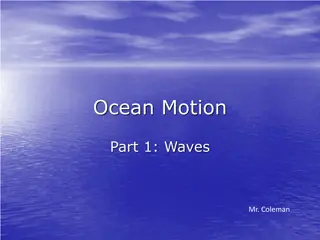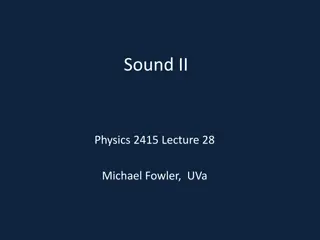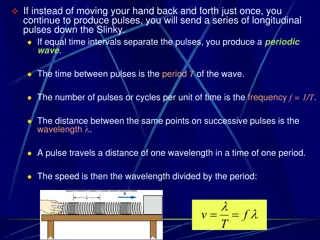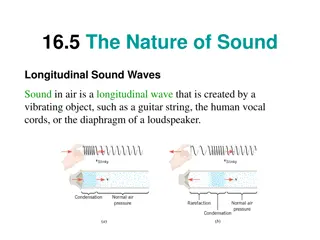Understanding Waves and Communication Systems in Middle School Science
Task designed for middle school students to explore properties of waves, electromagnetic radiation, and their role in communication systems. Incorporates Tennessee and NGSS standards, focusing on constructing explanations and modeling systems' interactions. Suggestions for classroom use provided to assess student progress. Prior knowledge of wave properties, electromagnetic radiation, and communication systems is assumed. Duration may span 2 class periods.
Download Presentation

Please find below an Image/Link to download the presentation.
The content on the website is provided AS IS for your information and personal use only. It may not be sold, licensed, or shared on other websites without obtaining consent from the author. Download presentation by click this link. If you encounter any issues during the download, it is possible that the publisher has removed the file from their server.
E N D
Presentation Transcript
Tennessee District Science Network Task Library Cell Phone Signal Teacher Guide Middle School Physical Science Three-Dimensional Claim In this task, students can draw on prior learning about properties and behaviors of waves to develop an explanation of the interactions of waves and components of communication systems using evidence about various types of electromagnetic radiation and the impact of building materials on wave transmission. Tennessee Academic Standards for Science This task is intended to elicit student learning of the following Tennessee Science Standards: 8.PS4.2: 8.PS4.2: Compare and contrast mechanical waves and electromagnetic waves based on refraction, reflection, transmission, absorption, and their behavior through a vacuum and/or various media. 8.PS4.3: 8.PS4.3: Evaluate the role that waves play in different communication systems. Next Generation Science Standards This task is intended to elicit student learning of the following NGSS elements for each of the three dimensions: Science and Engineering Practices Constructing Explanations and Designing Solutions Middle School Element: Apply scientific ideas, principles, and/or evidence to construct, revise and/or use an explanation for real-world phenomena, examples, or events. Disciplinary Core Ideas PS4.B: Electromagnetic Radiation Middle School Element: When light shines on an object, it is reflected, absorbed, or transmitted through the object, depending on the object s material and the frequency (color) of the light. PS4.C: Information Technologies and Instrumentation Middle School Element: Digitized signals (sent as wave pulses) are a more reliable way to encode and transmit information. Crosscutting Concepts Systems and System Models Middle School Element: Systems may interact with other systems; they may have sub-systems and be a part of larger complex systems. Middle School Element: Models can be used to represent systems and their interactions such as inputs, processes and outputs and energy, matter, and information flows within systems. Grade 3-5 Element: A system can be described in terms of its components and their interactions. These materials were developed by the Tennessee District Science Network, a NextGenScience network that included educators six districts in TN, with support from Arconic Foundation. Except where otherwise noted, this work is licensed under the Creative Commons Attribution-NonCommercial 4.0 International License. 1
Tennessee District Science Network Task Library Cell Phone Signal Teacher Guide Middle School Physical Science Suggestions for Use This task could be useful in the classroom setting to formatively reveal student progress in their knowledge of the core idea while offering students opportunities to practice constructing explanations and modeling. Teachers may find it useful at the beginning of instruction to use this task to make inferences about students prior understandings and then again at the middle or end of instruction to determine progress. Teachers using this task should make sure students are given additional opportunities to demonstrate that they can use grade level appropriate elements of the practices and crosscutting concepts to make sense of a phenomenon before making any claims about student proficiency within these dimensions. Assumptions Students should have prior knowledge of constructing explanations using models or data and communicating those explanations with a variety of modalities (written, drawings, models, charts, oral, etc.). They also require a working understanding of properties of waves, types of electromagnetic radiation used for information transfer, and the types of media through which waves are able to travel. An introduction to the use of waves to carry information in communication systems is necessary, as well as the ways wave energies may be changed as they travel within and between systems (ex. digitized information can be sent via radio waves, then changed to other forms of electromagnetic radiation to travel further and faster). Logistics The duration of the task depends on the length of the class period and could span 2 two-hour class periods. Prep work would include printing the teacher directions, teacher guide with grading rubrics, and task sheets for the students. Sources https://eyesaas.com/wifi-signal-loss/ https://www.cancer.org/cancer/cancer-causes/radiation-exposure/radiofrequency-radiation.html https://docs.google.com/document/d/1e0uhvZNjxC0HkKD8hxjUgIVGdbWmaJsgaQ_yFhyAnRE/edit?usp=sharing https://www.explainthatstuff.com/analog-and-digital.html http://www.planetoftunes.com/digital-audio/pros-and-cons-of-analogue-and-digital-audio.html#.XROp7-hKiUk 2
Tennessee District Science Network Task Library Cell Phone Signal Teacher Guide Middle School Physical Science Phenomenon and Stimulus A group of students are working together on a project for school in the downstairs basement area of their local library. The basement is entirely underground, with no windows. The friends begin to get a little hungry, and so Melody tries to use her cell phone to place a call to order pizza to be delivered. However, her cell phone doesn t have a signal and the call won t go through. The friends all think this is strange, because they know that there is a cell tower right outside of the library. The drawing below shows the layout of the library, the basement, and the communication systems in and around the library, and you may refer to this drawing throughout the task. 3
Tennessee District Science Network Task Library Cell Phone Signal Teacher Guide Middle School Physical Science Prompt 1 1a: Given the model below of the information transfer from Melody s phone to the pizza store, indicate with an X the location where the problem is occurring with the cell signal. What type of wave behavior is associated with this problem? Wave Behavior: ________________________________________ 1b: The chart below provides information about how building material can impact a cell phone signal. Cell phone signal is measured in units called decibel-milliwatts (dBm). In order to connect to make a call, the phone needs to be able to send and/or receive between 50 and 100 dBm. The chart shows the number of dBm that are absorbed or blocked by various building materials, shown in signal loss . Based on this information, construct an explanation to describe which material has most likely been used in the building that Melody and the students are working in. Assume (for simplicity s sake) that the library walls are built of a single material, not a combination. Building Material Effect on Cell Phone Signal (dBm) Concrete -55.2 Reinforced Concrete -53.8 Metal -41.0 Tinted or low-emissivity glass -32.0 Brick -15.3 Lumber -3.27 Traditional glass -0.07 Drywall -0 4
Tennessee District Science Network Task Library Cell Phone Signal Teacher Guide Middle School Physical Science Prompt 1 assesses: TN Standard TASS 8.PS4.2 Compare and contrast mechanical waves and electromagnetic waves based on refraction, reflection, transmission, absorption, and their behavior through a vacuum and/or various media. SEP Constructing Explanations and Designing Solutions Apply scientific ideas, principles, and/or evidence to construct, revise and/or use an explanation for real-world phenomena, examples, or events. CCC Systems and System Models Models can be used to represent systems and their interactions such as inputs, processes, and outputs and energy, matter, and information flows within systems. Prompt Scoring Guidance Score Components of Student Response (SEP, CCC, and/or DCI) Example Responses/Look Fors + 1 Student recognizes that the waves are blocked between the phone and cell tower. (DCI, SEP) X placed on flowchart between phone and cell tower. +1 Student mentions that the waves are carrying information (electromagnetic or radio waves) from the phone within the system. (DCI, CCC) The waves carrying information from Melody s phone cannot travel to the tower. + 1 Student names the wave behavior associated with the blocked signal. (DCI) Waves may be absorbed or reflected (not transmitted). + 1 Student identifies a higher-level signal blocking material as the library s material. (DCI) Hypothesizes the building is made of concrete, reinforced concrete, or metal. +1 Student explains a rationale for a building material that is working to absorb or block the wave transmission. (SEP) Defense of choice with data from the table (ex. concrete reduces wave transmission by 55.2 dBm, so the waves cannot travel through the walls.) Complete Student Response - Example Score and Score Rationale, if applicable: 1a: Cell Phone --X Cell Tower Pizza Store Wave Behavior: Absorption and/or Reflection +5 1b: I would predict that the walls in the library basement are made of concrete. Concrete is the building material listed that has the most impact on cell phone signals, reducing the signal by 55.2 dBm. The waves carrying information from Melody s phone cannot travel to the tower because Melody s phone signal is being blocked, and concrete blocks the most signals. 5
Tennessee District Science Network Task Library Cell Phone Signal Teacher Guide Middle School Physical Science Rubric Scoring Template - Prompt 1, Continued Incomplete Student Response - Example A Score and Score Rationale, if applicable: 1a: Cell Phone --X Cell Tower Pizza Store Wave Behavior: Absorption and/or Reflection +2 Correct on part A, incomplete/incorrect on part B. 1b: I would predict that the walls in the library basement are made of drywall. Drywall changes the signal -0, so that s why the signal can t get through--0 means no signal. Feedback & Next Steps for Students to Make Progress: - - What do the arrows in the flowchart represent? What does the negative sign (-) before dBm mean? If the material reduces the signal by that amount after the (-), which material reduces the signal the most? - Incomplete Student Response - Example B Score and Score Rationale, if applicable: 1a: Cell Phone Cell Tower --X Pizza Store Wave Behavior: Refraction +0 Incorrect placement of problem with signal, incorrect wave behavior, incomplete reasoning on part B. 1b: I would predict that the walls in the library basement are made of brick. Most basements I ve seen in are made of bricks. Feedback & Next Steps for Students to Make Progress: - If the phone isn t getting a signal, where does that signal come from? What words mean that waves cannot travel through something? What does the negative sign (-) before dBm mean? If the material reduces the signal by that amount after the (-), which material reduces the signal the most? - - - Score: Example of how you would score that response Scoring Rationale: Reasoning for the score you gave connected to the +1 statements from the scoring guide Feedback for Student: What feedback for the student would you recommend given the example response, with the goal of supporting learning toward missing components in their responses Scaffolds: To support lower-achieving students, consider: - providing a word bank of wave behaviors for prompt 1a (transmission, absorption, reflection, refraction) - directing students to draw and label waves leaving Melody s cell phone in the diagram - eliminating some choices from the building material table (ex. provide only concrete, brick, and drywall) 6
Tennessee District Science Network Task Library Cell Phone Signal Teacher Guide Middle School Physical Science Prompt 2 When Melody s phone wouldn t connect to call for pizza, she decided to use the WiFi connection on her cell phone to order pizza using the pizza store s website. Using the diagram of the library below as well as evidence from the data table in prompt #1, explain why Melody was able to connect to the pizza store via the WiFi internet communication system, but not her phone s cellular network system. 7
Tennessee District Science Network Task Library Cell Phone Signal Teacher Guide Middle School Physical Science Prompt 2 assesses: TN Standard TASS 8.PS4.2 Compare and contrast mechanical waves and electromagnetic waves based on refraction, reflection, transmission, absorption, and their behavior through a vacuum and/or various media. SEP Constructing Explanations and Designing Solutions Apply scientific ideas, principles, and/or evidence to construct, revise and/or use an explanation for real-world phenomena, examples, or events. CCC Systems and system Models (3-5) A system can be described in terms of its components and their interactions. Prompt Scoring Guidance Score Components of Student Response (SEP, CCC, and/or DCI) Example Responses/Look Fors + 2 Description of wave transmission in both systems: cell communication and WiFi internet communication (DCI, CCC) - Waves are required to send information to/from the cell phone and the cell tower outside Waves are required to send information to/from the laptop and the WiFi router - + 1 Discussion of the medium (building/wall/basement) preventing the wave transfer (DCI, SEP) - Cell phone waves cannot travel through the wall to the tower, so communication is interrupted. +/- 0 Discussion of wave behavior as it encounters the new medium (DCI, SEP) - Wave may be reflected, or absorbed by the building material (not transmitted) Complete Student Response - Example Score and Score Rationale, if applicable: Melody s phone couldn t connect to the store because the waves from her phone couldn t get to or from the cell phone tower outside. The concrete wall between Melody s phone and the cell tower is absorbing or reflecting the waves from her phone, so they cannot get to the tower. However, she could connect to the WiFi, because the router is inside the library, and there is nothing (like the concrete wall) blocking the waves from her laptop to and from the router. +3 Feedback/Questions to support next level thinking for students: - Possible extension: Where does the information go after it is received by the router? How is it changed? 8
Tennessee District Science Network Task Library Cell Phone Signal Teacher Guide Middle School Physical Science Rubric Scoring Template - Prompt 2, Continued Incomplete Student Response - Example A Score and Score Rationale, if applicable: Melody s phone couldn t connect to the store because the waves from her phone couldn t get to or from the cell phone tower outside. The concrete wall between Melody s phone and the cell tower is absorbing or reflecting the waves from her phone, so they cannot get to the tower. +2 Student response includes one of the two communication systems, and discussion of the wave interaction with the medium of the building system. Feedback & Next Steps for Students to Make Progress: - What are the two systems the phone is involved in? How are they similar? Different? Draw the signals to/from the phone for both the cell communication system and the WiFi communication system - Incomplete Student Response - Example B Score and Score Rationale, if applicable: Melody s phone couldn t connect to the store because the waves from her phone couldn t get to or from the cell phone tower outside. She could connect to the WiFi, because the router is inside the library, and the information goes from her laptop to and from the router. +2 Student response includes both of the communication systems, but no discussion of the interaction of the waves with the medium of the building system. Feedback & Next Steps for Students to Make Progress: - Draw the signals to/from the phone in the WiFi Draw the signals to/from the phone for both the cell communication system and the WiFi communication system Score: Example of how you would score that response Scoring Rationale: Reasoning for the score you gave connected to the +1 statements from the scoring guide Feedback for Student: What feedback for the student would you recommend given the example response, with the goal of supporting learning toward missing components in their responses Possible Scaffolds: - Consider providing sentence stems for students who struggle beginning the construction of their explanations (ex. Melody s phone couldn t connect to the cell communication system because or Melody was able to connect to the WiFi communication system because or The two communication systems the cell phone are a part of are ) 9
Tennessee District Science Network Task Library Cell Phone Signal Teacher Guide Middle School Physical Science Prompt 3 3a. This WiFi internet communication system has several components shown (out of order) below. Use symbols, arrows, and words to connect the components of this model of the Wi-Fi communication system Melody used to order the pizza. 3b. Construct an explanation of how energy flows into and out of the internet communication system to enable Melody to communicate with the pizza store, including how the energy changes forms during its transfer. 10
Tennessee District Science Network Task Library Cell Phone Signal Teacher Guide Middle School Physical Science Prompt 3 assesses: TN Standard TASS 8.PS4.3 Evaluate the role that waves play in different communication systems SEP Constructing Explanations and Designing Solutions Apply scientific ideas, principles, and/or evidence to construct, revise and/or use an explanation for real-world phenomena, examples, or events. CCC Systems and System Models Models can be used to represent systems and their interactions such as inputs, processes and outputs and energy, matter, and information flows within systems. Prompt Scoring Guidance Score Components of Student Response (SEP, CCC, and/or DCI) Example Responses/Look Fors + 1 Students model the flow of information in the internet communication system. (DCI, CCC) - cell phone router fiber optic cables pizza store +1 Students craft a written explanation including how the components of the system (cell phone, WiFi router, fiber optic cables) work together to change the forms of energy (EMR) and transfer them from one to another. - the parts of the internet communication system work together to allow Melody to communicate with the pizza store energy changes forms at different places in the system - + 1 Students make at least one mention of how the energy changes as it travels (DCI, SEP, CCC) - signal is digitized and sent via electromagnetic waves from computer to router OR digital signal is sent via a series of light pulses along the fiber optic cables OR pizza store computer turns light pulses back into digital information - - Complete Student Response - Example Score and Score Rationale, if applicable: 3a. cell phone (radio waves) router (light pulses) fiber optic cables pizza store +3 3b. The cell phone sends takes Melody s information, turns it into digital information coded in radio waves, and then sends that information through waves to the WiFi router. The router changes the energy to a series of light pulses, sent through fiber optic cables that carry the information to the pizza store computer system. 11
Tennessee District Science Network Task Library Cell Phone Signal Teacher Guide Middle School Physical Science Rubric Scoring Template - Prompt 3, Continued Incomplete Student Response - Example A Score and Score Rationale, if applicable: 3a. cell phone router fiber optic cables pizza store +2 No inclusion of the change in signal within the communication system. 3b. The cell phone transfers information through waves to the WiFi router, which is connected to fiber optic cables that carry the information to the pizza store computer system. Feedback & Next Steps for Students to Make Progress: - - Is the energy/signal the same at each step? What changes about the energy between __ and ___ (give 2 points of the system). What is a fiber optic cable made out of? - Incomplete Student Response - Example B Score and Score Rationale, if applicable: 3a. cell phone fiber optic cables router pizza store +0 Model is incorrect or out of order Feedback & Next Steps for Students to Make Progress: - Draw an arrow showing how the information is transferred on the diagram of the library Score: Example of how you would score that response Scoring Rationale: Reasoning for the score you gave connected to the +1 statements from the scoring guide Feedback for Student: What feedback for the student would you recommend given the example response, with the goal of supporting learning toward missing components in their responses Possible Scaffolds - Provide students with a printout of the Electromagnetic Spectrum, including examples at each wavelength as they explain how the information changes forms at different points in the system. - Provide additions to the word bank about changing forms of electromagnetic radiation along the pathway (ex. digitized information in radio waves, light pulses, etc.) 12
Tennessee District Science Network Task Library Cell Phone Signal Teacher Guide Middle School Physical Science Prompt 4 After Melody had trouble calling the pizza store, her friends wanted to help. Melody s friends made the following explanations and solutions to help Melody solve her problem: Mark: The phone s information waves don t have anything to carry it to the tower. You need to plug the phone into the outlet in the wall so that the signal can go through the wire. Luca: The phone s information waves can t get to the tower because you re holding it too tightly. You just need to hold the phone up above your head so that the signal can find your phone. Monique: The phone s information waves are being blocked by something here in the basement. You need to go outside to an open area so that the signal is stronger. Explain which friend you feel has the best solution to Melody s problem. Justify your choice with reasoning from your understanding of how information travels in communication devices, or by pointing out errors in the incorrect students thinking. Choice: Reasoning: 13
Tennessee District Science Network Task Library Cell Phone Signal Teacher Guide Middle School Physical Science Prompt 4 assesses: TN Standard TASS 8.PS4.2: Compare and contrast mechanical waves and electromagnetic waves based on refraction, reflection, transmission, absorption, and their behavior through a vacuum and/or various media. 8.PS4.3 Evaluate the role that waves play in different communication systems SEP Constructing Explanations and Designing Solutions Apply scientific ideas, principles, and/or evidence to construct, revise and/or use an explanation for real-world phenomena, examples, or events. CCC Systems and System Models: Systems may interact with other systems; they may have sub-systems and be a part of larger complex systems. Prompt Scoring Guidance Score Components of Student Response (SEP, CCC, and/or DCI) Example Responses/Look Fors + 1 Student suggests that waves are used to transfer information within the system of a cell phone network, and these waves interact with various media within the system. (DCI, SEP, CCC) Waves travel through open space. + 1 Students demonstrate understanding that waves are used to send/receive information by suggesting Monique s explanation. (DCI) Cell Phones use electromagnetic waves to send/receive information. + 1 Students demonstrate understanding that waves interact with various media within the system by suggesting that the waves are blocked. (DCI, CCC) Sometimes things get in the way of waves and affect how they travel. Complete Student Response - Example Choice: Monique Reasoning: Monique has the best solution to the problem. Melody s phone works using waves to send information, so she needs to be in an open area, where the waves can travel from her phone to the cell phone tower. Something must be blocking the signal. Mark s solution isn t the best, because electromagnetic waves, like those used by a cell phone, don t need a cord connection (a medium) for information to travel through. Luca isn t correct because his solution doesn t remove whatever is blocking the signal from getting to Melody s phone. Score and Score Rationale, if applicable: +3 Feedback/Questions to support next level thinking for students: 14
Tennessee District Science Network Task Library Cell Phone Signal Teacher Guide Middle School Physical Science Rubric Scoring Template - Prompt 4, Continued Incomplete Student Response - Example A Score and Score Rationale, if applicable: Monique has the best solution, because the waves need to travel from Melody s phone to the cell tower. +2 Student includes no explanation of how the waves are interacting with other components of the system (absorption/reflection by the basement walls). Feedback & Next Steps for Students to Make Progress: - Why can t the waves get to the tower where Melody is now? What is going on? Incomplete Student Response - Example B Score and Score Rationale, if applicable: Mark has the best idea because the waves need to travel along the wire from the cell tower to Melody s phone. +1 Student makes no mention of the interaction of waves with other components of the system and lacks understanding of the properties of electromagnetic waves within a communication system. Feedback & Next Steps for Students to Make Progress: - Do the waves from a cell phone need a wire as a medium? How do you know this? Why can t the signal get to the tower now? - Score: Example of how you would score that response Scoring Rationale: Reasoning for the score you gave connected to the +1 statements from the scoring guide Feedback for Student: What feedback for the student would you recommend given the example response, with the goal of supporting learning toward missing components in their responses Possible Scaffolds: - Have students model the pathways of each communication system (nonfunctional cell phone and functional WiFi system) on the drawing of the library. Point out the interaction of the communication system with the library construction. - Provide students with a printout of the electromagnetic spectrum, with functions of each wavelength of electromagnetic radiation. - Point out that Monique s explanation is the best, and have students write only the reasoning and/or point out incorrect reasoning for both Luca and Mark s solutions. These materials were developed by the Tennessee District Science Network, a NextGenScience network that included educators six districts in TN, with support from Arconic Foundation. Except where otherwise noted, this work is licensed under the Creative Commons Attribution-NonCommercial 4.0 International License. 15
